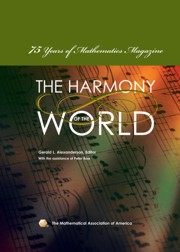Book contents
- Frontmatter
- Introduction
- Contents
- A Brief History of Mathematics Magazine
- Part I The First Fifteen Years
- Part II The 1940s
- Part III The 1950s
- Part IV The 1960s
- Part V The 1970s
- Part VI The 1980s
- Leonhard Euler, 1707–1783
- Love Affairs and Differential Equations
- The Evolution of Group Theory
- Design of an Oscillating Sprinkler
- The Centrality of Mathematics in the History of Western Thought
- Geometry Strikes Again
- Why Your Classes Are Larger than “Average”
- The New Polynomial Invariants of Knots and Links
- Briefly Noted
- The Problem Section
- Index
- About the Editors
The Centrality of Mathematics in the History of Western Thought
from Part VI - The 1980s
- Frontmatter
- Introduction
- Contents
- A Brief History of Mathematics Magazine
- Part I The First Fifteen Years
- Part II The 1940s
- Part III The 1950s
- Part IV The 1960s
- Part V The 1970s
- Part VI The 1980s
- Leonhard Euler, 1707–1783
- Love Affairs and Differential Equations
- The Evolution of Group Theory
- Design of an Oscillating Sprinkler
- The Centrality of Mathematics in the History of Western Thought
- Geometry Strikes Again
- Why Your Classes Are Larger than “Average”
- The New Polynomial Invariants of Knots and Links
- Briefly Noted
- The Problem Section
- Index
- About the Editors
Summary
Editors' Note: This essay was reprinted in the Magazine from the Proceedings of the International Congress of Mathematicians (American Mathematical Society, 1987), the congress held in Berkeley, California, 1986.
An undergraduate in mathematics at the University of Chicago, Grabiner went on to take her PhD at Harvard in the history of mathematics. Her books, The Calculus as Algebra/J. L. Lagrange 1736–1813 (Garland, 1990) and The Origins of Cauchy's Rigorous Calculus (MIT, 1981), are among the growing number of pieces she has written on the development of analytic geometry and calculus, with journal articles on Descartes, Fermat, Lagrange, Maclaurin, Weierstrass, and Cauchy. For her paper delivered at the Berkeley Congress she was awarded the Carl B. Allendoerfer Award by the MAA in 1989. This she added to her two other Allendoerfer Awards (1984, 1996) and her two Lester R. Ford Awards (1984, 1998). She has been given more awards for expository writing by the MAA than any other author.
Grabiner is the Flora Sanborn Pitzer Professor of Mathematics at Pitzer College, one of the Claremont colleges in California.
Introduction
Since this paper was first given to educators, let me start with a classroom experience. It happened in a course in which my students had read some of Euclid's Elements of Geometry. A student, a social science major, said to me, “I never realized mathematics was like this. Why, it's like philosophy!” That is no accident, for philosophy is like mathematics.
- Type
- Chapter
- Information
- Harmony of the World75 Years of Mathematics Magazine, pp. 237 - 246Publisher: Mathematical Association of AmericaPrint publication year: 2007



